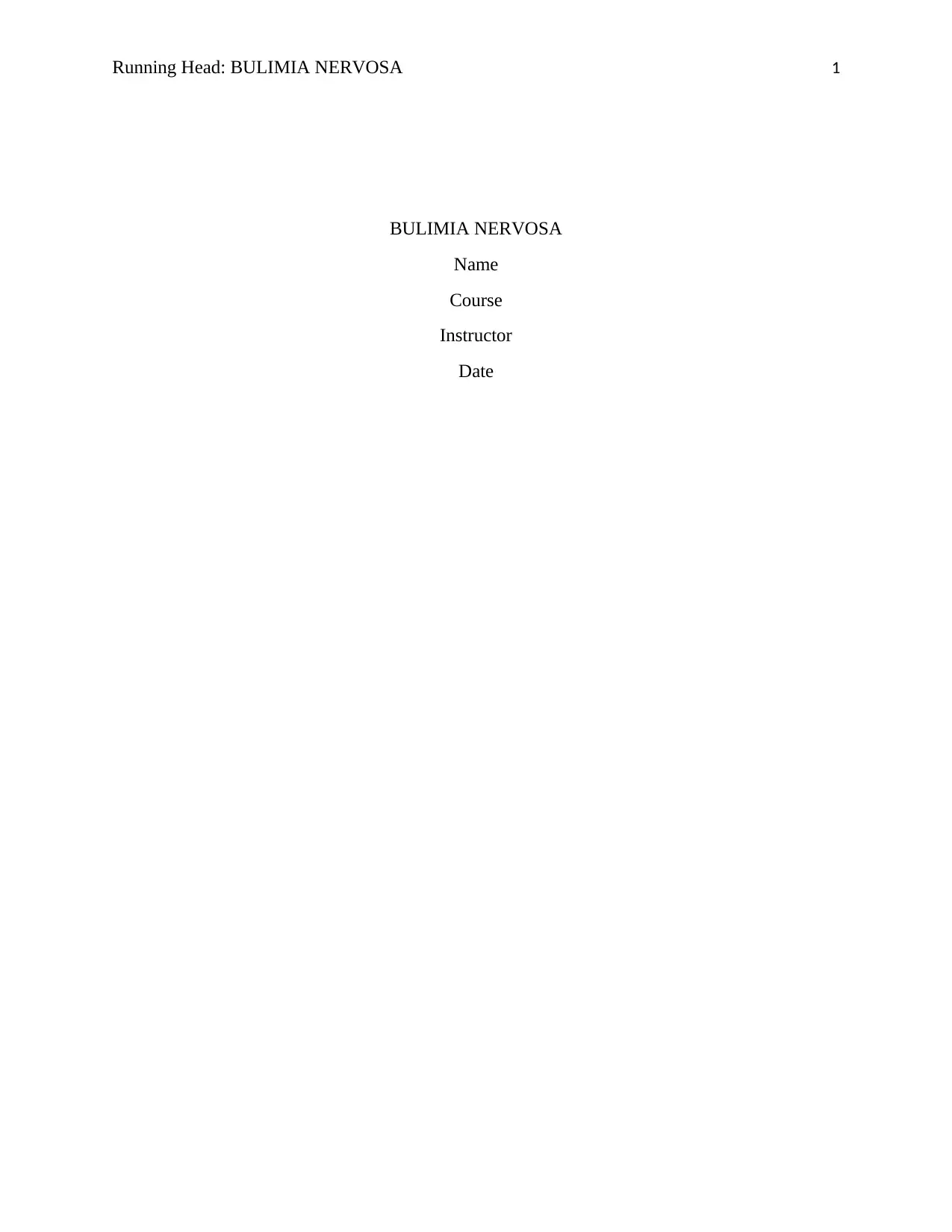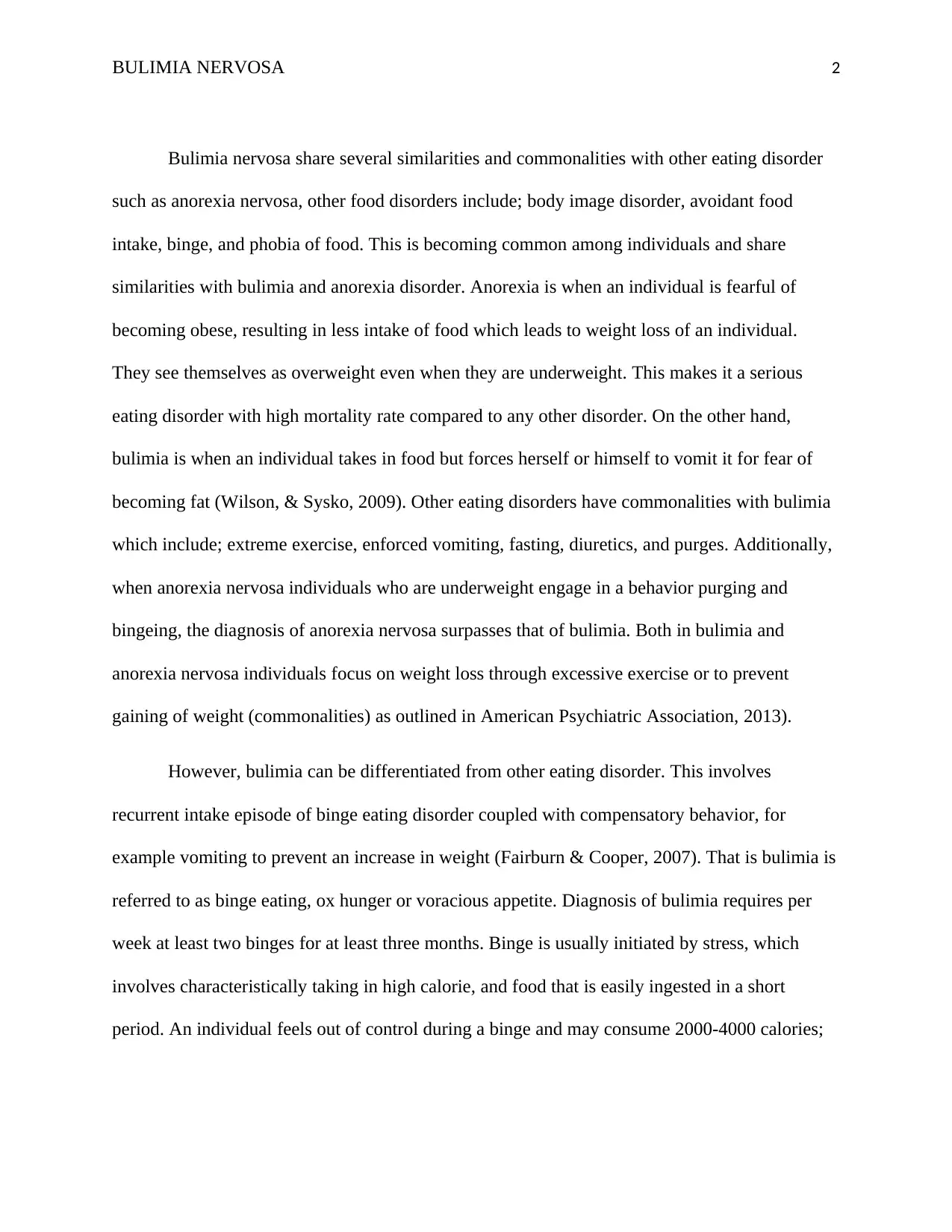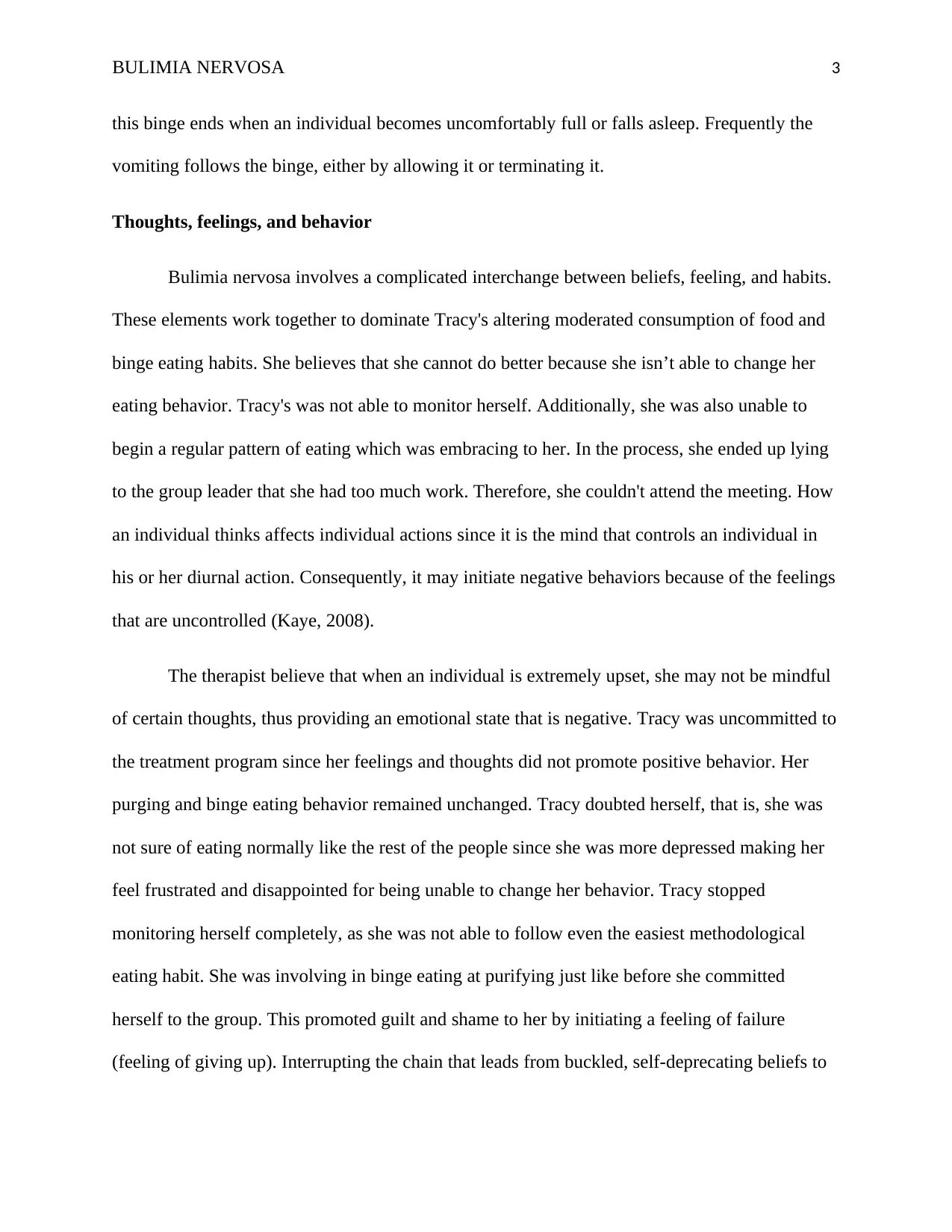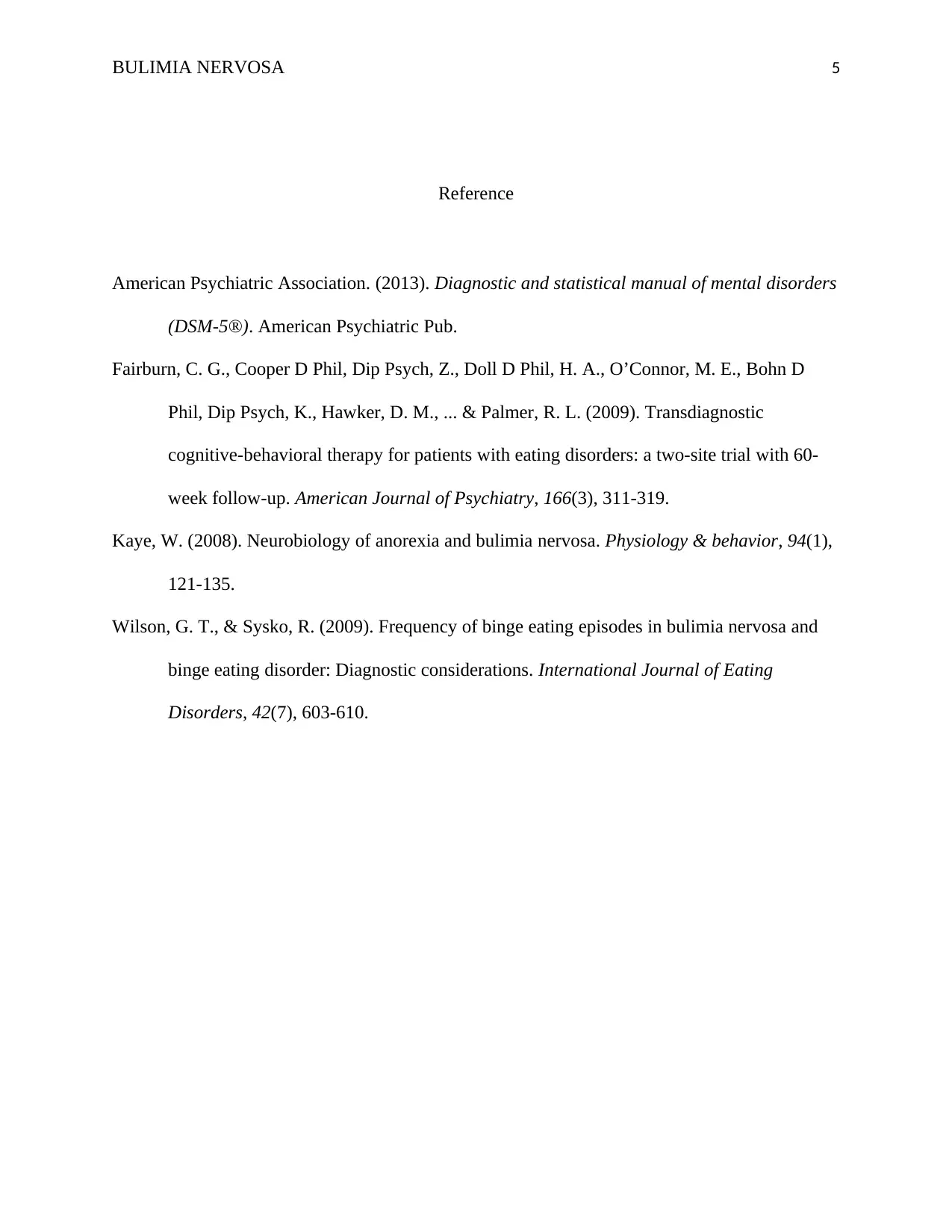Case Study: Bulimia Nervosa, Symptoms, and Treatment Challenges
VerifiedAdded on 2023/06/12
|6
|903
|212
Case Study
AI Summary
This case study examines Bulimia Nervosa through the experiences of Tracy, a 22-year-old college student. It highlights the similarities and differences between bulimia and other eating disorders like anorexia nervosa, focusing on the cycle of binge eating and compensatory behaviors such as vomiting. The analysis delves into the interplay of thoughts, feelings, and behaviors that perpetuate the disorder, emphasizing Tracy's struggles with self-esteem, academic stress, and social isolation. Her uncommitted approach to treatment, marked by negative feelings and a lack of self-monitoring, is also explored. The case underscores the importance of interrupting the chain of negative beliefs and behaviors in order to facilitate recovery from bulimia nervosa.

Running Head: BULIMIA NERVOSA 1
BULIMIA NERVOSA
Name
Course
Instructor
Date
BULIMIA NERVOSA
Name
Course
Instructor
Date
Paraphrase This Document
Need a fresh take? Get an instant paraphrase of this document with our AI Paraphraser

BULIMIA NERVOSA 2
Bulimia nervosa share several similarities and commonalities with other eating disorder
such as anorexia nervosa, other food disorders include; body image disorder, avoidant food
intake, binge, and phobia of food. This is becoming common among individuals and share
similarities with bulimia and anorexia disorder. Anorexia is when an individual is fearful of
becoming obese, resulting in less intake of food which leads to weight loss of an individual.
They see themselves as overweight even when they are underweight. This makes it a serious
eating disorder with high mortality rate compared to any other disorder. On the other hand,
bulimia is when an individual takes in food but forces herself or himself to vomit it for fear of
becoming fat (Wilson, & Sysko, 2009). Other eating disorders have commonalities with bulimia
which include; extreme exercise, enforced vomiting, fasting, diuretics, and purges. Additionally,
when anorexia nervosa individuals who are underweight engage in a behavior purging and
bingeing, the diagnosis of anorexia nervosa surpasses that of bulimia. Both in bulimia and
anorexia nervosa individuals focus on weight loss through excessive exercise or to prevent
gaining of weight (commonalities) as outlined in American Psychiatric Association, 2013).
However, bulimia can be differentiated from other eating disorder. This involves
recurrent intake episode of binge eating disorder coupled with compensatory behavior, for
example vomiting to prevent an increase in weight (Fairburn & Cooper, 2007). That is bulimia is
referred to as binge eating, ox hunger or voracious appetite. Diagnosis of bulimia requires per
week at least two binges for at least three months. Binge is usually initiated by stress, which
involves characteristically taking in high calorie, and food that is easily ingested in a short
period. An individual feels out of control during a binge and may consume 2000-4000 calories;
Bulimia nervosa share several similarities and commonalities with other eating disorder
such as anorexia nervosa, other food disorders include; body image disorder, avoidant food
intake, binge, and phobia of food. This is becoming common among individuals and share
similarities with bulimia and anorexia disorder. Anorexia is when an individual is fearful of
becoming obese, resulting in less intake of food which leads to weight loss of an individual.
They see themselves as overweight even when they are underweight. This makes it a serious
eating disorder with high mortality rate compared to any other disorder. On the other hand,
bulimia is when an individual takes in food but forces herself or himself to vomit it for fear of
becoming fat (Wilson, & Sysko, 2009). Other eating disorders have commonalities with bulimia
which include; extreme exercise, enforced vomiting, fasting, diuretics, and purges. Additionally,
when anorexia nervosa individuals who are underweight engage in a behavior purging and
bingeing, the diagnosis of anorexia nervosa surpasses that of bulimia. Both in bulimia and
anorexia nervosa individuals focus on weight loss through excessive exercise or to prevent
gaining of weight (commonalities) as outlined in American Psychiatric Association, 2013).
However, bulimia can be differentiated from other eating disorder. This involves
recurrent intake episode of binge eating disorder coupled with compensatory behavior, for
example vomiting to prevent an increase in weight (Fairburn & Cooper, 2007). That is bulimia is
referred to as binge eating, ox hunger or voracious appetite. Diagnosis of bulimia requires per
week at least two binges for at least three months. Binge is usually initiated by stress, which
involves characteristically taking in high calorie, and food that is easily ingested in a short
period. An individual feels out of control during a binge and may consume 2000-4000 calories;

BULIMIA NERVOSA 3
this binge ends when an individual becomes uncomfortably full or falls asleep. Frequently the
vomiting follows the binge, either by allowing it or terminating it.
Thoughts, feelings, and behavior
Bulimia nervosa involves a complicated interchange between beliefs, feeling, and habits.
These elements work together to dominate Tracy's altering moderated consumption of food and
binge eating habits. She believes that she cannot do better because she isn’t able to change her
eating behavior. Tracy's was not able to monitor herself. Additionally, she was also unable to
begin a regular pattern of eating which was embracing to her. In the process, she ended up lying
to the group leader that she had too much work. Therefore, she couldn't attend the meeting. How
an individual thinks affects individual actions since it is the mind that controls an individual in
his or her diurnal action. Consequently, it may initiate negative behaviors because of the feelings
that are uncontrolled (Kaye, 2008).
The therapist believe that when an individual is extremely upset, she may not be mindful
of certain thoughts, thus providing an emotional state that is negative. Tracy was uncommitted to
the treatment program since her feelings and thoughts did not promote positive behavior. Her
purging and binge eating behavior remained unchanged. Tracy doubted herself, that is, she was
not sure of eating normally like the rest of the people since she was more depressed making her
feel frustrated and disappointed for being unable to change her behavior. Tracy stopped
monitoring herself completely, as she was not able to follow even the easiest methodological
eating habit. She was involving in binge eating at purifying just like before she committed
herself to the group. This promoted guilt and shame to her by initiating a feeling of failure
(feeling of giving up). Interrupting the chain that leads from buckled, self-deprecating beliefs to
this binge ends when an individual becomes uncomfortably full or falls asleep. Frequently the
vomiting follows the binge, either by allowing it or terminating it.
Thoughts, feelings, and behavior
Bulimia nervosa involves a complicated interchange between beliefs, feeling, and habits.
These elements work together to dominate Tracy's altering moderated consumption of food and
binge eating habits. She believes that she cannot do better because she isn’t able to change her
eating behavior. Tracy's was not able to monitor herself. Additionally, she was also unable to
begin a regular pattern of eating which was embracing to her. In the process, she ended up lying
to the group leader that she had too much work. Therefore, she couldn't attend the meeting. How
an individual thinks affects individual actions since it is the mind that controls an individual in
his or her diurnal action. Consequently, it may initiate negative behaviors because of the feelings
that are uncontrolled (Kaye, 2008).
The therapist believe that when an individual is extremely upset, she may not be mindful
of certain thoughts, thus providing an emotional state that is negative. Tracy was uncommitted to
the treatment program since her feelings and thoughts did not promote positive behavior. Her
purging and binge eating behavior remained unchanged. Tracy doubted herself, that is, she was
not sure of eating normally like the rest of the people since she was more depressed making her
feel frustrated and disappointed for being unable to change her behavior. Tracy stopped
monitoring herself completely, as she was not able to follow even the easiest methodological
eating habit. She was involving in binge eating at purifying just like before she committed
herself to the group. This promoted guilt and shame to her by initiating a feeling of failure
(feeling of giving up). Interrupting the chain that leads from buckled, self-deprecating beliefs to
⊘ This is a preview!⊘
Do you want full access?
Subscribe today to unlock all pages.

Trusted by 1+ million students worldwide

BULIMIA NERVOSA 4
negative feelings and bingeing and purging habit is needed as stated American Psychiatric
Association (2013).
negative feelings and bingeing and purging habit is needed as stated American Psychiatric
Association (2013).
Paraphrase This Document
Need a fresh take? Get an instant paraphrase of this document with our AI Paraphraser

BULIMIA NERVOSA 5
Reference
American Psychiatric Association. (2013). Diagnostic and statistical manual of mental disorders
(DSM-5®). American Psychiatric Pub.
Fairburn, C. G., Cooper D Phil, Dip Psych, Z., Doll D Phil, H. A., O’Connor, M. E., Bohn D
Phil, Dip Psych, K., Hawker, D. M., ... & Palmer, R. L. (2009). Transdiagnostic
cognitive-behavioral therapy for patients with eating disorders: a two-site trial with 60-
week follow-up. American Journal of Psychiatry, 166(3), 311-319.
Kaye, W. (2008). Neurobiology of anorexia and bulimia nervosa. Physiology & behavior, 94(1),
121-135.
Wilson, G. T., & Sysko, R. (2009). Frequency of binge eating episodes in bulimia nervosa and
binge eating disorder: Diagnostic considerations. International Journal of Eating
Disorders, 42(7), 603-610.
Reference
American Psychiatric Association. (2013). Diagnostic and statistical manual of mental disorders
(DSM-5®). American Psychiatric Pub.
Fairburn, C. G., Cooper D Phil, Dip Psych, Z., Doll D Phil, H. A., O’Connor, M. E., Bohn D
Phil, Dip Psych, K., Hawker, D. M., ... & Palmer, R. L. (2009). Transdiagnostic
cognitive-behavioral therapy for patients with eating disorders: a two-site trial with 60-
week follow-up. American Journal of Psychiatry, 166(3), 311-319.
Kaye, W. (2008). Neurobiology of anorexia and bulimia nervosa. Physiology & behavior, 94(1),
121-135.
Wilson, G. T., & Sysko, R. (2009). Frequency of binge eating episodes in bulimia nervosa and
binge eating disorder: Diagnostic considerations. International Journal of Eating
Disorders, 42(7), 603-610.

BULIMIA NERVOSA 6
⊘ This is a preview!⊘
Do you want full access?
Subscribe today to unlock all pages.

Trusted by 1+ million students worldwide
1 out of 6
Related Documents
Your All-in-One AI-Powered Toolkit for Academic Success.
+13062052269
info@desklib.com
Available 24*7 on WhatsApp / Email
![[object Object]](/_next/static/media/star-bottom.7253800d.svg)
Unlock your academic potential
Copyright © 2020–2025 A2Z Services. All Rights Reserved. Developed and managed by ZUCOL.





